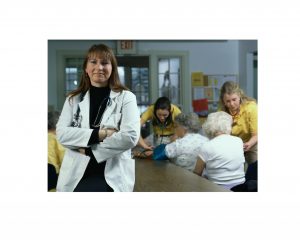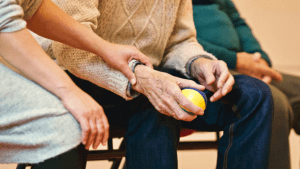Dr. Mauk’s Boomer Blog
Each week, Dr. Kristen Mauk shares thoughts relevant to Baby Boomers that are aimed to educate and amuse.
Dr. Kristen L. Mauk, PhD, DNP, RN, CRRN, GCNS-BC, GNP-BC, FAAN

Guest Blog: Everything You Need to Know About Tooth Discoloration in Seniors
A perfect smile with pearly teeth can be a real confidence booster. However, as you age, you might experience teeth discoloration. Therefore, it becomes important to understand what causes the discoloration of teeth in the elderly and what you can do about it.
Tooth Discoloration in Seniors
Teeth naturally are not perfectly white, and the color may vary from person to person. It ranges typically from white gray to light yellow in hue. However, in rare cases, it may be a bit more yellow or brownish despite good dental health. This visible color is of tooth enamel. It is the hard substance that protects the underlying delicate tissue of the tooth.
Enamel is the hardest substance in the body and shields the teeth. The purpose of enamel is to protect the surface of the teeth from erosion or stains. It further defends the teeth from sensitivity caused by very hot or cold foods and drinks.
As you age, the outer layer of the enamel on your teeth gets worn out to reveal the natural yellow color of dentin. Since the enamel does not have living cells, once damaged, it cannot grow back. Other than aging, there are other factors that contribute to tooth discoloration in seniors. Here are some of them:
1. Disease and medication
A number of diseases and treatments, including procedures like chemotherapy and radiation, can affect the teeth color. In addition, infections may also cause the natural teeth color to fade. Medications like tetracycline, doxycycline, antihistamines, and drugs for hypertension are also known to cause teeth discoloration.
2. Poor dental hygiene
Not brushing the teeth properly and skipping flossing can lead to yellow teeth as it will allow plaque to develop.
3. Foods, drinks, and tobacco
Certain foods and drinks like coffee, tea, wine, fruits, and vegetables can lead to teeth stains.
4. Excessive fluoride
Use of excessive fluoride, often found in teeth whitening products like toothpaste or mouthwash can cause yellowing of teeth.
5. Genes
Genetics can also be a major factor. Some people have more yellow tooth color than others, while others have thinner enamel.
How to treat discoloration in old age
Enamel, once destroyed, cannot be repaired. Therefore, the first thing you can practice is prevention. Nevertheless, teeth discoloration with age is unpreventable. Some of the treatments to get rid of teeth stains are mentioned below.
– Practice good dental hygiene and brush your teeth properly.
– Avoid foods or drinks that may cause staining.
– You may consult your dentist and consider bondings or veneers to hide or remove yellow teeth.
– Your dentist may be able to help you through teeth whitening procedures.
– Over-the-counter whitening agents can be the saviors in some cases.
Author Bio: Dr. Anu Isaac, DMD, runs a successful dental practice in Salem, MA. As the founder of Coral Dental Care, she is dedicated to creating healthy, beautiful smiles for her patients and also to educating dental and non-dental community with her engaging articles on all things related to oral health, recent dental innovations, and latest treatment modalities.
Guest Blog: Acupuncture: How It Works and the Various Benefits It Brings
 Acupuncture is a kind of traditional Chinese medicine that is based on the theory that a blockage or disruption in the flow of the body’s life force, or qi, can lead to health problems. Acupuncturists use small needles inserted into precise places on the body to balance energy, facilitate healing, and calm the body.
Acupuncture is a kind of traditional Chinese medicine that is based on the theory that a blockage or disruption in the flow of the body’s life force, or qi, can lead to health problems. Acupuncturists use small needles inserted into precise places on the body to balance energy, facilitate healing, and calm the body.
To say the least, acupuncture has a rich heritage. Documents detailing the practice date back to the first century BCE, but other archaeologists believe it dates back even further: maybe as far as 8,000 years ago.
It is a process where professional acupuncturists shallowly insert extremely thin needles into particular spots in the skin tissue in an attempt to unblock or alter divert the flow of energy. Acupoints are the names given to these points. Acupoints are counted in a variety of ways, although most systems count around 350-400 of them. Medical acupuncture is used for a variety of purposes, including pain reduction, and is now covered by many insurance policies.
To put things into perspective, let’s dive a little deeper.
How Acupuncture Works?
Endorphins are pain-relieving and pleasure-producing substances discovered by scientists in the 1970s. According to research, correctly conducted acupuncture can release endorphins, which can help with pain and nausea. It’s unclear how these small pegs trigger an endorphin surge.
It’s been tough to look into the practice. This is due to two key factors. The first is that various practitioners utilize different numbers of acupoints, prescribe varying amounts of sessions, and hold those sessions for varied lengths of time, which makes comparison difficult. The second problem for researchers is that people’s ideas and expectations, as well as how they feel about their therapist, may influence how effective the therapy seems to be in improving their diseases.
Benefits of Acupuncture
Most people are aware of acupuncture’s remarkable results on chronic pain relief and improved quality of life in people suffering from musculoskeletal ailments. This ancient therapeutic practice offers a slew of other physical, mental, and emotional advantages that few people are aware of. Acupuncture has a number of unexpected advantages, including the following:
Migraine and Headache:
Many people suffer from headaches on a regular basis. According to certain studies, stitching can give excellent, short-term relief for persistent tension headaches. Researchers have found that needle treatments for migraine headaches can be helpful even if they are not put in the right acupoints, and that they may have a larger impact than traditional medication therapy with fewer side effects.
Insomnia and Sleep Problems:
Acupuncture stimulates your body’s natural production of melatonin. This hormone governs your sleep-wake cycles when it is present in ideal proportions. It is typically underproduced today, owing to our contemporary lifestyle and bad sleeping habits, resulting in insomnia, frequent night awakenings, and constant exhaustion. If this continues for an extended period of time, it is a breeding environment for future health issues. Acupuncture can help you regain your natural ability to fall — and stay — asleep quickly.
Joint Pain:
Several studies and research suggested that acupuncture may be able to enhance the physical function of the knee in people with knee osteoarthritis in the short and long term. The connective tissue in the knee breaks down in this disorder. Acupuncture was also found to be effective in reducing knee discomfort in those with osteoarthritis of the knee, but only in the short term.
Energizes You:
Acupuncture can help you overcome lethargy or brain fog, whether you need a physical or mental energy boost to battle fatigue. An ideal set-point may be obtained and all organs can work properly by fully harmonizing the body’s energy environment. As a result, you may feel at peace, allowing you to get a better night’s sleep and become pain-free. Increased physical stamina and ability for clear and creative thinking result from stimulating the proper cerebral pathways.
Improves Digestion:
Acupuncture may cure practically all digestive issues by supporting the healthy functioning of the digestive system and its organs, as well as the rebalancing of possibly defective energy fields. While a lot of people walk towards dieting, we feel it is not sustainable. Acupuncture can assist with acute gastrointestinal disorders as well as severe symptoms of long-term persistent illnesses that have not been effectively treated, such as gallstones, Crohn’s Disease, or inflammatory bowel disease.
Enhances Fertility:
Acupuncture supports our reproductive systems and the appropriate synthesis of male and female hormones, making it a feasible option for couples struggling with infertility. Acupuncture may help a pregnancy develop smoothly, and it can even help the child’s position in the uterus be optimized for a natural and problem-free birth, protecting the mother’s fertility and physical reproductive health.
Maintains Blood Pressure:
In today’s world, rising blood pressure is an issue, especially with high-stress occupations and rising obesity rates. Regular acupuncture treatments, in combination with conventional therapy for the cardiovascular system, can help lower blood pressure. The technique supports appropriate cardiac function and blood flow, and it can be more successful in controlling blood pressure than medication.
Manages Menstrual Pain:
Acupuncture may help with dysmenorrhea, or painful periods, as well: Participants who got acupuncture reported as much relief from painful periods as those who took NSAIDs like ibuprofen or aspirin in a short research from 2013. In a 2008 research of 649 women, 15 acupuncture treatments spread out over three months were shown to be more effective than standard care in lowering menstruation discomfort and enhancing quality of life.
Final Takeaway
Acupuncture is widely accepted as a safe and effective treatment for a variety of ailments. Acupuncture sessions can last anywhere from 30 minutes to an hour, with the needles in for roughly 20 minutes. While the needles are implanted, some people may experience discomfort or pressure, while others may experience distinct feelings. Consult a professional acupuncturist if you’re not sure where to begin. An expert can show you where to apply pressure and how to do it correctly. For more information, you can reach out to us. We are always happy to help.
Guest Blog: Seniors and Broken Bones: The Long Road to Recovery

From a slight fracture to an arm to a full break in the shin or fractured hip, broken bones can be serious and result in months of therapy for recovery. When the injured person is a senior, the situation can be even more serious. They may be unable to remain in their own home and care for themselves, and in some cases, they are never able to return to their former level of independence.
Causes of Broken Bones
Falls are the main cause for broken bones in the elderly. They may also suffer a fracture due to a medical condition. It’s important to determine the cause so it can be prevented in the future and medical issues treated.
If the break occurs in either the legs or arms, hands or feet, the injury site may be placed in a cast and the limb immobilized. Some injuries are serious enough to require surgery. The patient may need pins or rods installed for the bones to stay in place until they heal.
Life After the Break
After the senior receives initial treatment for the break, the next step will to figure out care requirements. Depending on the location and severity of the break, the person may not be able to stay by themselves. They may have limited mobility and require assistance for daily tasks.
Even a minor break can sideline a senior more than someone younger. They may tire out easier, especially if the break requires them to move around on crutches.
An assisted living center is one option for seniors until their broken bones heal. Another option which might appeal more would be for them to hire an in-home caregiver. Even though family may want to help out, they have their own responsibilities. In certain situations, they may be able to be a paid family caregiver, which could ease the financial burden on the family and provide the assistance the senior needs until they’re back on their feet.
The Recovery Period
The senior will need to take certain steps to ensure their recovery is successful, and they can get back to their active lifestyle. This includes eating healthy, getting enough rest, and attending physical therapy and doctor appointments as recommended.
While enduring a broken bone for a senior can involve a lengthy recovery process, they can become independent once again with the right care.
Why Companion Care is More Important than You Think
Many seniors admit that as they grow old, they prefer to settle down and stay rooted. Aging in place has its benefits, but some family members might be concerned about the state of their elderly loved ones in such cases. Concerns such as house chores, safety, and general isolation are a problem for these situations. In such cases, it may be time to consider companion care.
Companion care is a type of long-term care tailormade for seniors and tackles many of the challenges of living alone as an elderly person. Today, we’ll talk about the benefits provided by companion care, and why it’s so important for the elderly to have someone taking care of them.
Independence
A helping hand does not mean an elderly person becomes even more dependent. If anything, companionship actually enhances the feeling of independence. The fact is that as we grow old, we become less capable of doing self-sufficient activities such as driving or sports. Some family caregivers may also start losing their sense of freedom, as all their time becomes dedicated to their aging family.
A companion reduces all those worries. With a companion, the senior now has someone who can watch over them as they go about their daily life. They don’t have to be stuck at home because now, someone is around to watch them. Family caregivers also lessen their stress because they share the responsibility with a professional. In turn, this makes the elderly family member feel less guilty.
Strong social bonds ensure that an elderly individual continues to be happy and active, even in the twilight of their life.
Companionship
Unsurprisingly, something called companion care provides this benefit in spades. Social connections are important in raising the self-esteem of the elderly. A companion lets your senior loved one enjoy the big and small things with a friendly companion.
It’s a minor benefit to some, but people severely underestimate how much having someone with you improves one’s mental health. A companion assists your loved ones by teaching them important self-care rituals such as meditation, massage, and morning hygiene.
Validation
A lot of elderly people dread the fact that the world is passing them by. They operate under the false assumption that they are nothing but a burden, and for those suffering from diseases such as Alzheimer’s, this feeling is doubled in their moments of lucidity. The fear of being a burden only strengthens with every passing year.
A companion alleviates all those issues. In addition to helping the elderly’s quality of life, they also provide a comfortable presence for them. Depression in advanced age can be prevented by someone simply being in a home with the person. Companions communicating with your senior family member means they will always feel seen and heard.
For example, if a senior family member performs an accomplishment, such as succeeding at a difficult hobby or task, the companion is there to provide them with emotional support. Validation is a powerful thing because no person wants to feel alone.
Comfort
For the elderly, sudden change can be incredibly upsetting. Moving to a new place, their children leaving to start their own lives, and a plethora of other life stuff could be very detrimental to their mental state. Anxiety, fear, and depression are common for lonely senior citizens. Thus, most senior citizens prefer the comforts of settling down.
Companionship in a familiar place, such as a family home, leads to many benefits. Familiarity, comfort, and safety are only some of the benefits that come with staying in one place with a companion to care for them. Practically, it’s usually financially viable as there are no moving costs and also means they stay close to the friends they have made in the neighborhood.
Peace of Mind
Lots of family members may be concerned about leaving their elderly loved ones alone. Many senior adults do not like the idea that they make their children/younger family members feel “guilty” for leaving them. For the family who does choose to become caretakers, feelings of bitterness and depression may also ensue. Some cannot shoulder the anxiety of not having 100% of their time belong to them.
Hiring a companion fixes a lot of these issues. Some may balk at this idea as shoving responsibility of a loved one onto someone else, but that is simply untrue. Having your own free time is also important in caring for your loved one. They would not enjoy the idea of being your anchor (in the negative sense).
In addition, companions are trained exactly for this purpose. Certain things that you may struggle with are not a problem for a professional companion. They are trusted to give all of their focus to your loved one.
Conclusion
Companion care is a beneficial decision. The benefits above clearly outline why companion care should not be set aside as a “half-measure” in taking care of your elderly loved ones. Companions enhance your loved one’s life, and they are NOT a replacement for you. Make sure that you still visit your senior loved one regularly, and stay in contact with their companion for updates.
Guest Blog: Managing Back Pain as You Age
Like other critical parts of the musculoskeletal system, the spine experiences some wear and tear over the decades. Does this mean back pain is inevitable as you get older? Not necessarily.
What Happens to Your Spine as You Age?
The spine itself is composed of a series of stacked bones called vertebrae. Small joints between each vertebra allow for the spine’s range of movement and little rubbery discs with jelly-like centers inside make sure bones don’t rub against one another (they also serve as the spine’s shock absorbers).
Over time, these disks can dry out, shrink, and wear away, causing the spine to compress. This is known as degenerative disc disease. Sometimes the space surrounding the spinal cord will start to narrow too; this is known as spinal stenosis. Arthritis and osteoporosis may also affect the spine as you age leading to joint degradation and even spinal fractures.
Any of these age-related conditions can contribute to back pain, especially when bones start rubbing against one another and nerves get pinched. The body may even go as far as to grow bone spurs in an effort to stabilize a degenerating spine.
Preventing and Managing Back Pain
So, is there anything older adults can do to prevent it or at least manage the pain and discomfort that comes with those types of conditions? Definitely.
Experts recommend taking actions to relieve some of the burden your spine bears during daily activity. This includes:
- Exercising to strengthen your back and core to more properly support the spine
Practicing good posture when sitting, using the computer, texting, etc.
Wearing a back brace for added posture support and lumbar compression
Eating a healthy diet rich with anti-inflammatory foods that help you maintain a healthy weight and combat systemic inflammation in they body – think fresh fruits, vegetables, whole grains, nuts, seeds, legumes, and lean proteins
Reducing stress on the back. This may mean utilizing lumbar cushions when driving, updating your mattress to better support your spine when sleeping, and avoiding activities which exacerbate your back pain
Additional Thoughts
Of course, it is also important to remember that acute back pain can also stem from something as simple as a muscle strain. Lifting something heavy, straining your arms and neck reaching for something in an awkward position, even sitting for a long period of time in an uncomfortable chair – any of these things can cause back pain and inflammation.
Skin Cancer Warning Signs
With summer upon us, we are happy to get out and enjoy the change from the long Indiana winter. However, prolonged exposure to that bright sunshine can have dire consequences for us as we age. The risk of skin cancer is higher in older adults, and the major risk factor is sun exposure. Although there are other less serious forms of skin cancer (basal cell and squamous cell), malignant melanoma is the most dangerous kind, accounting for more than 8,700 deaths per year (American Cancer Society, 2013).
As we age and our skin becomes more fragile, sun exposure can take its toll. You can be proactive in preventing skin cancer by following some simple tips:
Wear sunscreen when out in the sun and choose SPF 15 or higher every day, but choose SPF 30 with a waterproof barrier for long exposure. Avoid tanning booths. Wear clothing and hats that protect you from exposure. Ask your primary care provider to perform a skin check with your yearly physical, or visit your dermatologist if you have concerns. Know your own skin and check it regularly using the ABCDE method. Report any suspicious lesions to your doctor right away for follow-up.
The ABCDE method can help us remember the warning signs of skin cancer:
A = Asymmetry (if a line is drawn down the middle of the lesion, the two sides do not match)
B = Border (the borders of the lesion tend to be irregular)
C = Color (a variety of colors is present; the lesion is not uniform in color)
D = Diameter (MM lesions are usually larger)
E = Evolving (note any changes in shape or size, or any bleeding)
The good news is that even the most serious kind of skin cancer can be nearly 100% curable when detected early.
So, enjoy the sun, but be sun smart as well!




